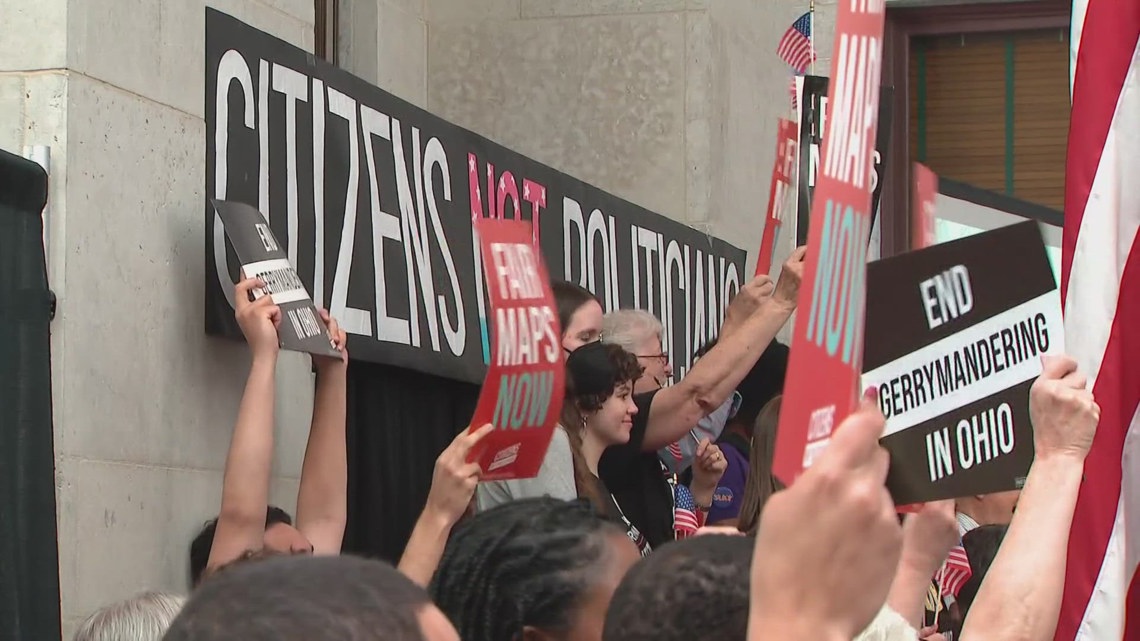TOLEDO, Ohio — Ohio Issue 1 has been the subject of some confusion ahead of Election Day. For example, some yard signs encouraging "yes" and "no" votes on the issue both claim to ban gerrymandering, the term used to describe political mapmaking processes that favor one party over the other.
If you have questions about what exactly Ohio Issue 1 would do, if passed, then you're not alone. The ballot language itself is nearly 1,000 words in length, and may appear daunting while you're casting your vote on Election Day or during early voting.
Here's what the proposed state constitutional amendment would do, if passed.
What would Ohio Issue 1 do?
Issue 1, if passed by a majority "yes" vote, would create a redistricting commission for Ohio. This commission would be in charge of drawing district boundaries that are used in elections.
This commission would be called the "Ohio Citizens Redistricting Commission." It would consist of 15 members:
- 5 people from the largest political party
- 5 people from the second largest political party
- 5 independents
How would the commission members be selected?
Here's how these commission members would be selected under Issue 1:
- A bipartisan screening panel of four retired judges will review and screen applicants
- The judge panel will review 90 applicants
- 30 from the largest political party
- 30 from the second largest political party
- 30 independents
- The judge panel will then narrow applicants down to 45 finalists
- 15 from each pool
- The judge panel will randomly draw six applicants from these finalists, and select the remaining nine commissioners.
What will the commission do?
- Hold public meetings and hearings to gather input and ensure transparency
- Create new district maps that are fair and comply with federal laws, including the Voting Rights Act
- The commission must avoid gerrymandering and ensure districts reflect the political preferences of Ohio voters


How can the public participate in the commission?
- The commission will use technology to broadcast meetings and facilitate public participation
- Citizens can provide input through official meetings, hearings and an online portal
Legal challenges
- The Ohio Supreme Court will have exclusive jurisdiction over any legal challenges to the redistricting plans.
- Special masters (experts) may be appointed to help resolve disputes.


How will the commission be funded?
The state will fund the commission, including member pay, staff, consultants and legal expenses, through public funds from taxpayers. According to cost estimates put forth by the Ohio Office of Budget and Management, one year of commission expenses would likely cost the state of Ohio $5.7 million, with the two largest expenses being staffing costs and potential litigation of the redistricting plan once it's adopted.
The document from the OBM notes, "Issue 1 as proposed creates a new Ohio Citizens Redistricting Commission. As such, there will be activities that require public expenditures, including but not limited to salaries of commissioners, staff and retired judges who select the commissioners, expenses to hold public meetings, equipment and supplies related to drawing district maps, and the cost of litigation." You can read the entire cost analysis here.
When and how often will the commission work?
The new commission will begin work on the mapmaking process, should Issue 1 pass, by May 16, 2025. It will then make maps again every 10 years afterward.
What rules would the commission have to follow when drawing maps?
- Districts must be contiguous (connected) and comply with federal laws.
- The proportion of districts favoring each political party should closely match the statewide preferences of voters.
- Districts should preserve communities of interest (areas with shared interests) as much as possible.
- At least nine of the 15 commissioners would have to agree on the map for it to be used
What if the commissioners can't agree on a map?
If commissioners can't agree on a plan, then a ranked-choice voting process will be used to select a plan
Can a commissioner run for office?
No, a commissioner cannot hold elected or appointed state office in Ohio for six years after their term ends.
What would happen to the current maps? Who made them?
- All existing maps will be voided if Issue 1 passes. These current maps were created by the existing Ohio Redistricting Commission.
- This commission consists of three statewide elected officials and four state lawmakers. It is composed of two Democrats and five Republicans.
- Ohioans voted in 2015 to create the commission and have it draw Statehouse districts. During that bipartisan campaign, called Fair Districts for Ohio, they were promised the new system would "protect against gerrymandering.” In 2018, voters gave the commission an additional role in a new system set up to draw congressional districts.


Who proposed Ohio Issue 1?
Ohio Issue 1 was proposed by Citizens Not Politicians, a bipartisan campaign whose aim, it said, is to end gerrymandering in Ohio.
The group sued the Ohio Ballot Board, who approved the language that will appear on the ballot. Citizens Not Politicians has called the language on the ballot biased and claims it describes the opposite of its intentions.
The Ohio Supreme Court upheld the language in a September ruling.
Editor's note: This story has been updated to correct the political makeup of the Ohio Redistricting Commission.

